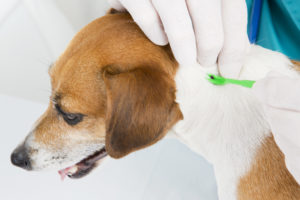
This guide will help you better understand Lyme disease in dogs.
Lyme disease is a significant and potentially debilitating condition that affects both humans and animals. If left untreated, it may lead to a range of health problems in dogs. This guide will help you better understand Lyme disease in dogs, recognize the symptoms, familiarize yourself with diagnosis and treatment, and, most importantly, know how to prevent this dangerous disease.
How Dogs Get Lyme Disease
Lyme disease in dogs comes from the bacterium Borrelia burgdorferi, which happens through the bite of infected black-legged ticks, prevalently known as deer ticks. These ticks are common in wooded and grassy areas, and dogs that spend time in these environments are at a higher risk of getting bitten. The ticks must be attached for 36-48 hours to transmit the bacteria effectively. This prolonged attachment period means regular tick checks can substantially reduce the risk of infection.
Symptoms of Lyme Disease in Canines
The symptoms of Lyme disease in dogs might vary widely and may not appear until several months after the initial tick bite. Common signs to watch for include:
- Lameness: Dogs may exhibit intermittent lameness due to inflammation in the joints, often shifting from one leg to another.
- Fever: An unexplained fever can be a sign of Lyme disease.
- Swollen Joints: Inflammation and swelling in the joints are common.
- Lethargy: Dogs might become less active or seem unusually tired.
- Loss of Appetite: A decrease in appetite indicates that something is wrong.
- Kidney Issues: In severe cases, Lyme disease can lead to kidney problems, which can be life-threatening.
These symptoms can often be mistaken for other conditions, so it’s crucial to consult a veterinarian if your dog shows any abnormal behavior or health issues.
Diagnosis of Lyme Disease
Diagnosing Lyme disease in dogs involves several steps. A vet will typically begin with a thorough physical exam and a review of the dog’s medical history. Blood tests are commonly practiced to detect the presence of antibodies against Borrelia burgdorferi. One such test is the C6 antibody test, which can identify specific proteins the bacterium produces. Additional examinations, such as polymerase chain reaction (PCR) tests, may be conducted to detect bacterial DNA in the dog’s blood or tissues. In some cases, joint fluid analysis is performed to identify inflammation indicative of Lyme disease.
Treatment of Lyme Disease
The leading treatment for Lyme disease in dogs is antibiotics, with doxycycline being the most commonly prescribed. The duration of antibiotic therapy typically lasts four weeks but can be extended if symptoms persist. In some cases, more medications may be required to address specific symptoms, like anti-inflammatory drugs for joint pain and swelling. It’s crucial to complete the entire course of antibiotics, even if symptoms improve, to ensure that the infection is fully eradicated. Follow-up appointments with the vet are necessary to oversee the dog’s progress and adjust treatment if needed.
Prevention of Lyme Disease
Preventing Lyme disease in dogs is far more effective than treating it. Here are several strategies to protect your dog from this debilitating disease:
- Tick Control Products: Use veterinarian-recommended tick preventatives, such as topical treatments, oral medications, and tick collars, which can help repel and kill ticks.
- Regular Tick Checks: After outdoor activities, thoroughly check your dog for ticks, especially in areas like the ears, neck, and between toes.
- Vaccination: Lyme disease vaccines are available for dogs and can provide an additional protection layer, especially for those in high-risk areas.
- Environmental Management: Keep your yard well-maintained by mowing the lawn regularly and removing leaf litter and tall grasses where ticks thrive.
- Avoid Tick-Infested Areas: Limit your dog’s exposure to known tick habitats, particularly during peak tick seasons in the spring and fall.
By implementing these preventive measures, you can significantly minimize the risk of your dog contracting Lyme disease.
Support Your Pet’s Wellness at Alexander Animal Hospital
Alexander Animal Hospital is a full-service animal hospital located in Severna Park, Maryland, serving the Severna Park, Pasadena, and Arnold Areas. Our goal is educating clients on the needs of their pets and understanding the importance of individualized veterinary care in order to strengthen the human-animal bond between owners and their pets.
We understand you have a choice when deciding on the care for your pets, and we strive to provide you with unparalleled services including wellness exams, vaccines, lost pet microchip ID, dental care, surgical services, digital radiography, and in-hospital laboratory services and diagnostics. Other highlights of Alexander Animal Hospital are the separate cat and dog waiting and exam rooms, as well as after-hours on-call emergency services.
Please take a look around our website and then give us a call at 410-777-8678 to set up an appointment. We’re social! Follow us on Facebook, Twitter, and Pinterest for all the latest updates!
